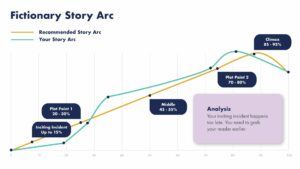
It’s time to dive into the oft-turbulent seas of self editing. Now, let’s get one thing straight off the bat. Editing your own work can feel like trying to find your car keys in the middle of a chaotic children’s birthday party. It’s overwhelming, confusing, and there’s a good chance someone is crying in the corner (usually me).
But don’t fret.
Like any daunting task, you can tame the self editing beast. I’m here to share my trusty roadmap to help you navigate the wilderness of your manuscript without losing your sanity–or your sense of humour.
My early days of self editing were quite the ride. It was a journey of endless circling, constant second-guessing, and a nagging feeling that there had to be a more streamlined way to tackle this beast. That’s when I discovered Fictionary, and oh boy, was that a life saver.
Picture this.
It’s like suddenly having your own personal story guide, one who provides structure and focus amid the self editing chaos.
With Fictionary, you’re not just wandering through your manuscript, aimlessly pruning here and there. No. You’re on a mission, equipped with a coherent plan and a powerful tool that ensures you’re consistently hitting the right notes in your story.
Fictionary was the lifeboat I never knew I needed in the choppy waters of editing.
It transformed my approach, turning a task I used to creep up to with dread into an engaging, even enjoyable process. And if it can do that for an edit-averse writer like me, imagine what it can do for you. So, fasten your seatbelts, folks. We’re about to embark on a whirlwind tour of self editing that will revolutionise the way you shape your stories.
Onward to self editing enlightenment, and remember, laughter is mandatory.
Why is Editing Your Own Writing So Difficult?

You’re Too Close to Your Writing
With your own writing, you’re often as attached as a koala to a eucalyptus tree. Your stories are our brainchildren, lovingly crafted through hours of writerly toil. That’s why editing your own work can feel like trying to tell your best friend they’ve got spinach in their teeth…
It’s just awkward.
We’ve all been there. You’ve just written a scene that you think is as dramatically charged as a season finale of your favourite TV show. But when you return to it a few days later, you realise it has all the emotional punch of a damp napkin. You were just too close to see it clearly.
Being intimately involved with your story has its perks. Like knowing your characters better than your next-door neighbour. However, this closeness can also blind you to plot holes, inconsistencies, and other narrative missteps. It’s like trying to read a book that’s pressed against your nose.
You’re just too close to see the full picture.
So how do you combat this?
By using tools like Fictionary to give you the perspective you need. With Fictionary, you’re provided with an objective lens through which to view your narrative. It’s the equivalent of getting a pair of super cool self editing binoculars. So, pull on your editing gloves, folks.
Let’s dig into how to conquer this challenge.
It’s Hard to Know Where To Start
Starting to self edit is like walking into a mega warehouse of a store without a shopping list.
There are aisles upon aisles of narrative to explore. Characters loitering in one corner. Plot twists hanging out in another. And don’t get me started on the check-out lane where punctuation errors are having a party.
So where on earth do you start?
When you’ve got a manuscript sprawling out before you, like an unruly garden where words have grown wild and free, it can be downright intimidating. You can often find yourself in a paralysis of analysis, grappling with the fear of ‘what if I prune the wrong branch?’
The key is to have a plan, an editing roadmap if you will.
A structured approach can help you break down the massive task into manageable, bite-sized chunks. Start with a macro view, focusing on story elements such as characters, plot, and setting. Then slowly zoom in, to the micro-level details like sentence structure, word choice, and punctuation.
And guess what?
Fictionary can help you create that roadmap, so you’ll never feel lost again.
It’s like having a GPS for your manuscript, ensuring you don’t miss any important sights along your editing journey.
It’s Impossible To Know When You’re Finished
Okay, picture this…
You find yourself knee-deep in your manuscript. You’ve tamed your unnecessary adverbs. Your character arcs are looking more curved than a crescent moon. You’ve patched up all your plot holes. You’re feeling good, like you’ve nailed this self editing thing. But then, the question hits you like a sneaky plot twist.
When do I stop?
Knowing when to step away from your manuscript is one of the hardest parts of self editing. It’s like trying to quit eating potato chips after you’ve opened the bag.
One more chip.
One more read-through.
It feels like a never-ending cycle, doesn’t it?
Self editing could indeed go on forever if you let it, because no story is absolutely perfect. There’s always another plot point to tweak, another sentence to polish. But we need to recognise when our edits are no longer making significant improvements, but just changes.
And here’s where Fictionary swaggers in, like the hero in a cowboy novel. Its structured approach not only helps you focus on what’s important, but also tells you when it’s time to mosey on. When you’ve addressed the 38 Story Elements Fictionary highlights, you can confidently say, ‘It’s high noon, and I am done.”
How to Edit Your Own Writing: 5 Tips to Self-Edit

1. Let Your Manuscript Rest
Hold your horses! I know, I know. You’ve just written ‘The End’ on your manuscript and now you’re brimming with adrenaline, ready to dive into editing. But hold on. It’s time to play the waiting game. And I’m not talking about waiting for the pizza to arrive. This is more like waiting for cheese to mature (or wine, if you prefer).
You’ve been knee deep in your story for a while now.
It’s been in your morning coffee thoughts. Your afternoon daydream. And probably even your midnight insomnia companion. You know every character, every plot twist, and every adverb you might have overused. And that’s exactly why you need a break.
Give your story a rest. Take a step back. Detach. You might feel you’re abandoning your newborn, but trust me, it’s for the best. Take at least a couple of weeks, maybe even a month. Start another project, delve into those books you’ve been meaning to read, or go on a Netflix binge.
When you return to your manuscript, it’ll be with a fresh pair of eyes.
You’ll spot the clunky dialogue, the slow-paced scenes, and those adverbs that you thought were oh-so-clever. But don’t fret—that’s the point. With a rested mind, you’re ready for the editing adventure ahead.
So, take that breather.
Your manuscript (and your sanity) will thank you for it.
2. The First Read Through: Name Your Scenes In 3 Words Or Less
Now you’re well-rested and eager to start your editing journey.
It’s time to dive into the deep end. But before you do, let’s ease into it. We’re going to start with a fun exercise. It’s time to become the Lord of Titles, the Queen of Catchy Phrases, the… well, you get the idea.
As you read through each scene in your manuscript, give it a name. And not just any name. A name in three words or fewer. Sounds easy, right? Well, that’s where the challenge lies. It forces you to get to the core of what the scene is about, to distil it to its essence. Is it ‘Betrayal at Dawn’? Or ‘Lost Love Letter’? Maybe it’s ‘Alien Abduction Afternoon’? Who knows, it’s your story.
Why do this, you ask
It gives you a bird’s eye view of your story, an outline if you will. It helps you identify if a scene is contributing to your plot or if it’s just wandering about like a lost puppy. If you can’t nail down what a scene is about, perhaps it’s not clear or focused enough.
This is a simple, yet incredibly powerful self-editing technique. It not only sharpens your scenes, but also helps structure your narrative.
Plus, it’s kind of fun, isn’t it?
3. Edit Your Story
The Story Arc

Alright folks.
Buckle up because we’re diving head-first into the magical realm of the Fictionary Story Arc, an essential part of any successful narrative.
The Story Arc, in simple terms, is the heartbeat of your tale.
It’s the series of events that propels your characters from the beginning to the climax and through to the resolution. Picture it as a rollercoaster ride. There are highs, lows, loops, and whirls that take your characters—and your readers—on an unforgettable journey.
Now, what makes the Fictionary Story Arc stand out in the crowd of storytelling models? Well, it’s like your favourite superhero. Equipped with superpowers to help you conquer the mountain of narrative structure.
The Fictionary Story Arc is laser-focused on three pivotal points in your narrative:
- The Inciting Incident: The event that disrupts your protagonist’s everyday world
- Plot Point 1: When your protagonist engages with the central story conflict
- Midpoint: Where another big event shifts the protagonist to an active state
- Plot Point 2: A tragedy that brings your protagonist to their lowest moment
- Climax: Where the protagonist resolves the central story conflict
It ensures your story has a satisfying rise and fall, essential for keeping your readers hooked.
Let’s put on our lab coats for a moment and think of it as a science experiment. You wouldn’t mix random chemicals together and hope for the best, right? Well, the same logic applies to your story. Without a solid structure—without the Story Arc—your narrative might just fizzle out or, worse, blow up in your face.
The Fictionary Story Arc provides that framework, giving your story the right mix of elements for a successful reaction. It considers your plot point placement, the tension and stakes, and the pacing.
It’s like having a secret recipe for a delectable story stew.
So why does the Fictionary Story Arc work so well? Because it respects the timeless principles of storytelling. It also gives you the flexibility to weave your unique narrative. It’s not a restrictive box, but a supportive scaffold, guiding your story to its most engaging form. And let’s be honest. Who doesn’t love a well-structured, gripping tale?
POV Character Goals
Oh, the joy of characters in fiction.
They’re the lifeblood of our stories, the beating hearts that draw our readers in and make them care. But here’s the kicker. Characters, especially your point-of-view (POV) characters, need goals. Without goals, they’re just aimlessly wandering around your narrative, and that’s about as exciting as watching paint dry.
When self editing, sharpen your focus on your POV characters and their goals.
What do they want more than anything else in the world? How does that desire shape their actions, decisions, and interactions with other characters? Remember, their goal should be specific, tangible, and ideally, a smidgen out of reach.
And it’s not just about setting the goal, it’s about the pursuit.
How does your POV character strive for their goal, stumble, pick themselves up, and keep on fighting? The struggle, the resilience, the triumph, the heartbreaking failure. This turns your characters from mere words on a page. It turns them into living entities your readers will root for, cry for, and remember long after they’ve turned the last page.
Self editing for character goals is difficult. But it’s what gives your narrative depth and dynamism. So grab that red pen (or sign into the Fictionary Software) and make those characters work.
Setting: The Five Senses
And now, my fellow wordsmiths, we step into the vibrant world of setting.
But this isn’t just about where your story happens. Oh no, it’s about the sights, the sounds, the smells, the tastes, and the textures. In short, it’s about engaging all five senses.
Here’s the key benefit: you can create a truly immersive reading experience. You want your readers to feel like they’re right there with your characters, experiencing everything they are. This is where the magic of the five senses comes into play.
So, as you edit, take a moment to experience your setting through your characters’ eyes. What do they see? Is it the azure sea stretching to the horizon, or the crumbling wallpaper in a dimly lit room? And it’s not just about what they see. What’s the scent wafting in the air? The tang of salty sea breeze, or the musty odour of damp and decay? What can they hear, touch, taste?
Leveraging the five senses in your setting can make your story pop in high-definition 3D in your reader’s mind. And let me tell you, dear writer, nothing beats the magic of storytelling through setting.
So grab your literary paintbrush and create some sensory-rich settings.
4. Edit Your Prose and Proofread

Copy Editing
And now we step into the realm of Copy Editing, the abode of the ever-vigilant Grammar Police. It’s like being on a scavenger hunt for hidden glitches that could trip up your readers.
Dear scribes, when we’re caught in the throes of crafting our story, we neglect the technical aspects of writing. We might end up with run-on sentences, inconsistencies in tense, or even those pesky punctuation errors.
Enter the superhero of our tale: Copy Editing. This process involves a line-by-line scrutiny of your manuscript. Ironing out grammatical gaffes. Clarifying murky sentences. Ensuring your style is consistent throughout. It’s like giving your story a good, thorough polish until it gleams with clarity.
But remember…
This isn’t about changing your unique voice as a writer. It’s about refining it, making sure your voice comes through loud, clear, and error-free.
Proofreading
Just when you thought you were done, along comes Proofreading. The ultimate boss level in your self editing video game. This is your last line of defence against any typos, missed commas, or other minor errors that escaped the earlier stages of self editing.
Now, you may be tempted to think of proofreading as the less exciting cousin of the more ‘creative’ self editing stages. But don’t let proofreading fool you. Proofreading has saved many writers from the horror of spotting a typo in their published work.
During proofreading, you’re searching for minor errors like a literary detective.
Misspelt words, incorrect punctuation, spacing issues, you name it. If it’s a tiny error that disrupts the smooth reading experience, it’s got to go.
The goal here is precision. It’s about putting that final shine on your manuscript, making it as flawless as a freshly polished diamond. So, it’s time to don your Sherlock Holmes hat, magnifying glass in hand, and begin the thrilling hunt for those elusive errors.
5. Hire a Professional Editor
As a Fictionary Certified StoryCoach Editor, let me tell you why our services are awesome for any writer looking to enhance their story’s appeal.
We’re not your traditional proofreaders or copy editors.
No. We’re akin to the dedicated crew behind the stage of a great production. We tweak the backdrop. We finesse the lighting. And we ensure the principal actors—your characters, plot, and setting—deliver a spectacular performance.
Our focus is story editing or developmental editing. This is a meticulous process that delves deeper than commas and spelling errors. We examine the macro elements of your narrative. And we pay attention to your story arc, character development, pacing, and settings.
Using the powerful Fictionary software, we dissect your manuscript. Best of all, you get comprehensive and objective feedback.
This technology grants us an eagle-eyed view of your narrative. It enables us to spot and address structural issues that may otherwise go unnoticed.
Our role, as Fictionary Certified StoryCoach Editors, is to accompany you on your creative journey. We guide you through the wilderness of your narrative. We don’t change your voice or your vision.
Heaven forbid.
Instead, we help you enhance them. We’re your trusted allies, your second pair of eyes, and your sounding board.
In the end, working with a Fictionary Certified StoryCoach Editor equips you with deeper insights into your story, empowering you to sculpt it into the best possible version. We don’t just help you write a story. We assist you in crafting a memorable experience for your readers.

FAQs: Editing Tips For Writers

Why Is Self Editing Important?
Self editing is a key step in your writing journey.
It’s not just a spellcheck or a grammar-fix. Oh, no. It’s about refining your narrative, strengthening your plot, and deepening your characters. It’s like running a comb through a tangled mane, smoothing out inconsistencies, and forming a clear, interesting story.
When you self-edit, you see your work from a reader’s perspective. And hey, wouldn’t you want to make sure your story is in the best shape before it steps out into the world?
What Are The Most Common Story Editing Mistakes?
Common story editing mistakes include:
- Hazy character motivations
- Inconsistent plot developments
- Underdeveloped settings
- And more…
Another classic mistake is pacing. Too slow, and your readers are snoring. Too fast, and they’re left scratching their heads. Avoiding these pitfalls comes down to keeping a keen eye on your narrative’s building blocks.
You must ensure they work harmoniously together.
What Are The Most Common Prose Editing Mistakes?
Prose editing mistakes often slip under the radar but can disrupt your reader’s flow. These mistakes include:
- Overuse of adverbs
- Too much telling instead of showing
- Purple prose (writing that’s excessively ornate or flowery)
- Confusing sentence structure
- And more…
These are just some typical culprits.
Another common issue is inconsistent voice, which can confuse readers. Then there’s the ever-prevalent problem of typos and grammatical errors. Remember, your prose is the vehicle that carries your story.
A smooth ride makes for a much more enjoyable journey.
Conclusion: Self Editing Tips

Fellow writers, we’ve traversed all the self editing twists and emerged enlightened. Editing isn’t an afterthought. It’s pivotal to a captivating narrative, acting as your story’s personal trainer.
Giving your manuscript a breather ensures a more objective self-review. Outlining your scenes provides clarity and uncovers plot inconsistencies.
Story editing, including:
- Shaping the story arc
- Honing your POV character’s goals
- Infusing your setting with sensory details
All this transforms a narrative from rough draft to polished novel. Copy editing and proofreading apply the final touches, the gleam that sets your story apart.
And remember…
Seeking professional help from a Fictionary Certified StoryCoach Editor can elevate a decent manuscript to a stunning one.
Self editing isn’t destructive. It’s an exploration of your narrative’s strengths and weaknesses, refining it to its peak. No ‘one-size-fits-all’ approach exists. Every story is unique and deserves tailored nurturing.
Finally, self editing is more than a duty. It’s an art. It complements your creative writing process, preparing you for the dual role of creator and critic. With these tips, you’re ready to write and then refine your masterpiece.
Article Written by Shane Millar

Shane Millar is a Fictionary Certified Story Coach and the author of the Write Better Fiction craft guides. He is also the author of the Myth & Magic and Chosen Vampire urban fantasy thriller series.
Shane holds a BA in journalism and is a member of The Alliance of Independent Authors (ALLi). He lives in Buckinghamshire, England.
He has taken too many writing courses to count and enjoys reading as much as possible. Shane is obsessed with five things: the writing craft, mythology, personal development, food, and martial arts movies.
Want to hire Shane to edit your novel? Visit: https://swmillar.com/editing


